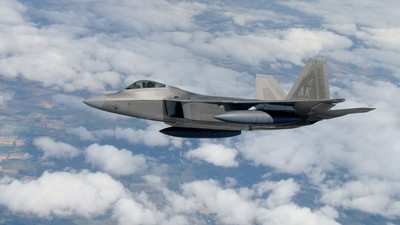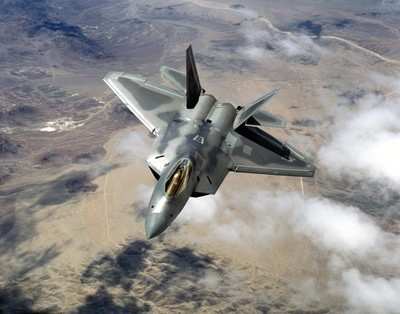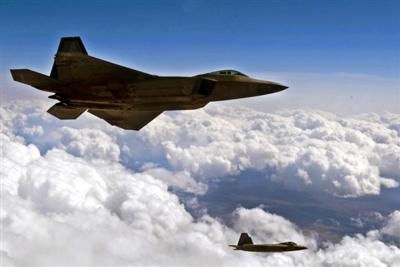Appear As Whistle Blowers With Congressional Protection
In an interview aired Sunday by the CBS news magazine 60 Minutes, two of the pilots who have refused to fly the F-22 due to concerns about the oxygen system spoke out about those concerns. The pilots are risking their careers by refusing to fly the airplanes.

Two pilots, Maj. Jeremy Gordon and Capt. Josh Wilson, received protection as whistleblowers from Congressman Adam Kinzinger (R-IL), who also appeared on the program.
CBS reports that both men stopped flying the Raptor in January. Maj. Gordon told Leslie Stahl that he had "no control over what's coming through that tube," attached to his oxygen mask. He said there might be a point where he might not be in control while he's flying. But asked directly by Stahl if he thought the airplane was safe, he said he was not comfortable answering that question. But he did say he was also not comfortable flying the F-22.
Capt. Wilson told Stahl about his experiences with hypoxia symptoms while flying the airplane. He said at one point he tried to pull the emergency oxygen ring, but "couldn't find it" despite his extensive training. Wilson told Stahl that F-22 pilots often take out additional insurance policies. He said that they are "waiting for something to happen," and no one will be surprised when it does.
In a story posted to the USAF website on Saturday, before the story aired, Gen. Mike Hostage, commander of Air Combat Command, said the status of efforts to identify a root cause for unexplained physiological incidents, and risk mitigation efforts since the Raptor's return to flying operations in September 2011.

Hostage's remarks were taken from a session with media held at Langley AFB in Virginia April 30. Confirming recent media reports of the F-22 deploying to Southwest Asia, Hostage emphasized the Raptor's ability to support combatant commander requirements around the world. "I won't comment where it's deployed to or where it deployed from, but yes, the F-22 is on an operational deployment now. And this is not the first operational deployment," he said. "If your adversary is so concerned about what your capabilities are they decide not to engage with you, that to me is the ultimate use of your military capability. People pay attention to where this airplane goes and what it does...we need to make sure that it's a sustained part of our inventory."
The command-directed stand down from May to September 2011 was a prudent measure following reports of potential oxygen system malfunctions. Since the stand down, ACC has implemented a number of risk mitigation measures intended to protect F-22 pilots and maintenance crews and prevent future incidents.
Hostage said he understands there are still concerns about the aircraft; however, he explained that there's always a certain amount of risk involved, and the risk must be balanced with the requirement for the capability. "In a peacetime training circumstance, we want to operate at as low of risk is prudent for the level of training we get out of a mission," he said. "When we go into combat, risk goes up, but the reason to assume that risk goes up as well. We live in a community where risk is part of our lives," he said. "If we think the risk has gone to a level where we just can't accept it, we either reduce that risk or eliminate it. But right now, we believe that risk -although it's not as low as we would like it - is low enough to safely operate the airplane at the current tempo."

Hostage said he believes this risk is not a risk he expects his Airmen to take alone. In an effort to learn more about the aircraft and get a better understanding of what F-22 pilots are dealing with, ACC's commander will soon begin flying the Raptor. "I'm asking these guys to assume some risk that's over and above what everybody else is assuming, and I don't feel like it's right that I ask them to do it and then I'm not willing to do it myself -- that's not fair," he said, adding that the day they figure out what the problem is the day he will stop flying.
Since the aircraft resumed flying operations in September, the F-22 has flown more than 12,000 sorties and returned to operational capability. "We've taken a very specific, methodical approach to how we return to flying -- the types of missions and the durations of the missions," said Maj. Gen. Charles Lyon, ACC director of operations. "We've been continually increasing the types and durations."
The Air Force continues to search for the root cause of the unexplained physiological incidents using detailed data-collection methods, which will soon include centrifuge and high-energy testing. Hostage said he believes the command is making significant progress toward an answer; however, he emphasized that scientific testing and data collection take time. "I believe we are making significant progress toward an answer," said Hostage. "I don't want to characterize how far or when because I don't own the progress of science. But I am confident we're going to get to a solution."

Both Lyon and Hostage compared this to the early days of the F-16. Although the first F-16 had its first operational flight in 1970, the combat edge aircrew flight equipment, which was optimized for high-G flight, wasn't fielded until about 1988, Lyon said. "We didn't field it slowly because we had fiscal challenges - it took us that long to get the understanding over time of what was actually happening."
Hostage illustrated a similar analogy regarding the unknown effects of human physiology and technology. "What we're looking at is human physiology and the regime this airplane operates in," he said. "This airplane does things airplanes have never done before in regimes of flight that we've never operated in before."
And Hostage said he's confident they will find a solution for what he calls "the most tactically-capable aircraft in the world."
"This nation needs this airplane - and every one of them," he said. "I wish I had ten times as many as I have."
 Classic Aero-TV: The Switchblade Flying Car FLIES!
Classic Aero-TV: The Switchblade Flying Car FLIES! ANN FAQ: Q&A 101
ANN FAQ: Q&A 101 ANN's Daily Aero-Term (04.12.24): Discrete Code
ANN's Daily Aero-Term (04.12.24): Discrete Code ANN's Daily Aero-Term (04.13.24): Beyond Visual Line Of Sight (BVLOS)
ANN's Daily Aero-Term (04.13.24): Beyond Visual Line Of Sight (BVLOS) ANN's Daily Aero-Linx (04.13.24)
ANN's Daily Aero-Linx (04.13.24)






